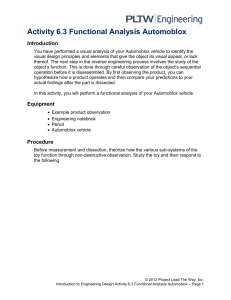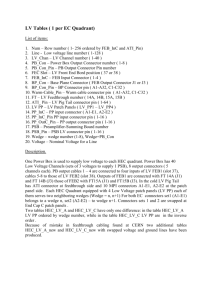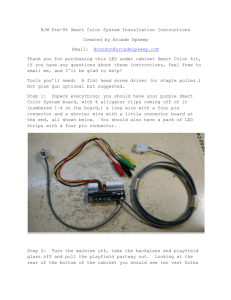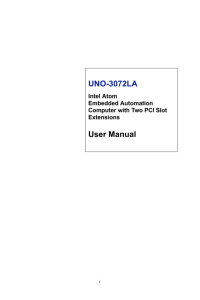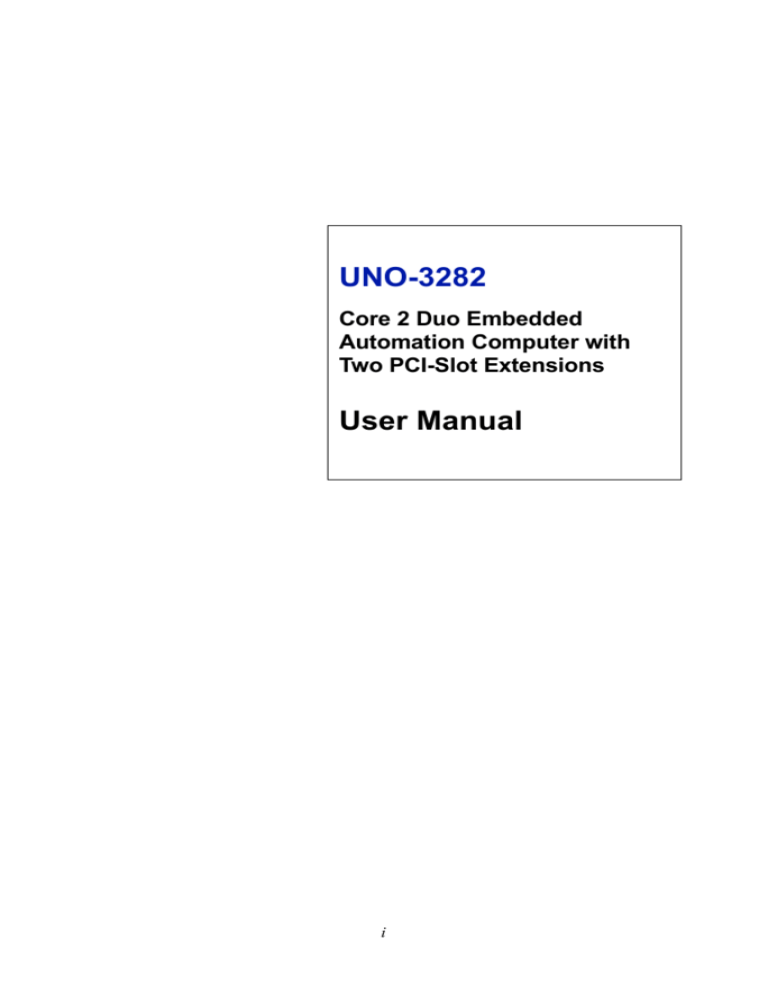
UNO-3282
Core 2 Duo Embedded
Automation Computer with
Two PCI-Slot Extensions
User Manual
i
Copyright
This document is copyrighted, © 2008. All rights are reserved. The original manufacturer reserves the right to make improvements to the products
described in this manual at any time without notice.
No part of this manual may be reproduced, copied, translated or transmitted in any form or by any means without the prior written permission of
the original manufacturer. Information provided in this manual is intended
to be accurate and reliable. However, the original manufacturer assumes
no responsibility for its use, nor for any infringements upon the rights of
third parties that may result from such use.
Acknowledgements
Intel®, Pentium® and Celeron® are registered trademarks of Intel Corporation. Microsoft® Windows and MS-DOS are registered trademarks of
Microsoft® Corp. All other product names or trademarks are properties of
their respective owners.
Support
For more information on this and other Advantech products, please visit
our websites at: http://www.advantech.com
For technical support and service, please visit our support website at:
http://www.advantech.com/support/
Part No. 2003328201
2nd Edition
Printed in Taiwan
October 2008
UNO-3282 User Manual
ii
Product Warranty (2 years)
Advantech warrants to you, the original purchaser, that each of its products will be free from defects in materials and workmanship for two years
from the date of purchase.
This warranty does not apply to any products that have been repaired or
altered by persons other than repair personnel authorized by Advantech, or
which have been subject to misuse, abuse, accident or improper installation. Advantech assumes no liability under the terms of this warranty as a
consequence of such events.
Because of Advantech high quality-control standards and rigorous testing,
most of our customers never need to use our repair service. If an Advantech product is defective, it will be repaired or replaced at no charge during
the warranty period. For out-of-warranty repairs, you will be billed according to the cost of replacement materials, service time and freight. Please
consult your dealer for more details. If you think you have a defective
product, follow these steps:
Step 1: Collect all the information about the problem encountered. (For
example, CPU speed, Advantech products used, other hardware and software used, etc.) Note anything abnormal and list any on- screen messages
you get when the problem occurs.
Step 2: Call your dealer and describe the problem. Please have your manual, product, and any helpful information readily available.
Step 3: If your product is diagnosed as defective, obtain an RMA (return
merchandize authorization) number from your dealer. This allows us to
process your return more quickly.
Step 4: Carefully pack the defective product, a fully completed Repair
and Replacement Order Card and a photocopy proof of purchase date
(such as your sales receipt) in a shippable container. A product returned
without proof of the purchase date is not eligible for warranty service.
Step 5: Write the RMA number visibly on the outside of the package and
ship it prepaid to your dealer.
iii
CE
This product has passed the CE test for environmental specifications. Test
conditions for passing included the equipment being operated within an
industrial enclosure. In order to protect the product from being damaged by
ESD (Electrostatic Discharge) and EMI leakage, we strongly recommend
the use of CE-compliant industrial enclosure products.
FCC Class A
This equipment has been tested and found to comply with the limits for a
Class A digital device, pursuant to Part 15 of the FCC Rules. These limits
are designed to provide reasonable protection against harmful interference
when the equipment is operated in a commercial environment. This equipment can generate, use and radiate radio frequency energy and, if not
installed and used in accordance with the instruction manual, may cause
harmful interference to radio communications. Operation of this equipment in a residential area is likely to cause harmful interference in which
case the user will be required to correct the interference at his own
expense.
CAUTION
The computer is provided with a battery-powered real-time clock circuit.
There is a danger of explosion if battery is incorrectly replaced. Replace
only with same or equivalent type recommended by the manufacture.
Discard used batteries according to the manufacturer’s instructions.
Technical Support and Assistance
Step 1: Visit the Advantech web site at www.advantech.com/support
where you can find the latest information about the product.
Step 2: Contact your distributor, sales representative, or Advantech's customer service center for technical support if you need additional assistance. Please have the following information ready before you call:
- Product name and serial number
- Description of your peripheral attachments
- Description of your software (OS, version, application software, etc.)
- A complete description of the problem
- The exact wording of any error messages
UNO-3282 User Manual
iv
Contents
Chapter
Chapter
1 Overview .......................................................... 2
1.1
1.2
Introduction ....................................................................... 2
Hardware Specifications ................................................... 4
1.3
1.4
Safety Precautions ............................................................. 6
Chassis Dimensions........................................................... 7
1.5
Packing List....................................................................... 8
1.2.1
Figure 1.1:Chassis Dimensions ...................................... 7
Figure 1.2: Accessories .................................................. 8
2 Hardware Functionality ............................... 10
2.1
Introduction ..................................................................... 10
2.2
2.3
RS-232 Interface (COM1~COM2) ................................. 11
RS-232/422/485 Interface (COM3~COM4) ................... 11
2.4
2.5
LAN: Ethernet Connector ............................................... 17
Power Input ..................................................................... 17
2.6
2.7
2.8
USB Connector .............................................................. 18
VGA Display Connector ................................................. 18
Battery Backup SRAM ................................................... 18
Figure 2.1:Front Panel of UNO-3282 .......................... 10
Figure 2.2:Rear Panel of UNO-3282 ........................... 10
2.3.1
2.3.2
2.3.3
2.9
IRQ and Address Setting ............................................. 14
Switch Setting for SRAM and Display Port. ............... 15
PCIe Configuration ...................................................... 16
Figure 2.3:Location of Power Input ............................. 17
2.8.1
Chapter
Interface: ........................................................................ 4
Figure 2.4:LED Location for Battery Backup ............. 18
Lithium Battery Specification ...................................... 19
Figure 2.5:Lithium Battery for SRAM ........................ 19
Reset Button .................................................................... 19
3 Initial Setup.................................................... 22
3.1
3.2
3.3
3.4
3.5
Inserting a CompactFlash Card ....................................... 22
Connecting Power ........................................................... 22
Installing a Hard Disk ..................................................... 23
Installing a PCI-bus Card ................................................ 26
BIOS Setup and System Assignments ............................ 27
Appendix A System Settings and Pin Assignments ......... 30
A.1
A.2
System I/O Address and Interrupt Assignments ............. 30
Board Connectors and Jumpers....................................... 32
A.3
RS-232 Standard Serial Port (COM1~COM2) ............... 34
A.4
RS-232/422/485 Serial Port (COM3~COM4) ............... 35
Figure A.1:Mainboard Connector & Jumpers ............. 32
Table A.3:Connector and Jumper Descriptions ........... 33
Table A.4:RS-232 Serial Port Pin Assigns .................. 34
Table A.5:RS-232/422/485 Serial Port Pin Assigns .... 35
v
Table of Contents
A.5
Ethernet RJ-45 Connector (LAN1~LAN2)..................... 35
A.6
Power Screw Terminal .................................................... 36
A.7
PS/2 Keyboard and Mouse Connector ............................ 36
A.8
USB Connector (USB1~USB4) ...................................... 37
A.9
VGA Display Connector ................................................. 37
A.11
PCI-express Connector (Optional) .................................. 39
Table A.6:Ethernet RJ-45 Connector Pin Assigns ....... 35
Table A.7: Phoenix Power Connector Pin Assigns ..... 36
Table A.8:Keyboard & Mouse Connector Pins ........... 36
Table A.9:USB Connector Pin Assignments ............... 37
Table A.10:VGA Adaptor Cable Pin Assignmen ........ 37
Appendix B Programming the Watchdog Timer ............ 42
UNO-3282 User Manual
vi
CHAPTER
1
Overview
This chapter provides an overview of
UNO-3282 specifications.
Sections include:
• Introduction
• Hardware specification
• Safety precautions
• Chassis dimensions
Chapter 1 Overview
1.1 Introduction
Standard PCs and some industrial computers with a standard OS and hardware for the consumer market cannot provide the reliability required by
industrial automation and embedded industrial control applications. However, many engineers prefer to use PCs because of their advanced functions such as: analog control and simulation, database connectivity, webbased applications, and communication with third-party devices. UNO3282 combines the best features of a PC, including the processor, RAM,
and powerful software, with the reliability, ruggedness, and distributed
nature of a PLC. UNO-3282 has the compact size and ruggedness of a PLC,
and the software flexibility and functionality of a PC. It's an ideal platform
for sophisticated control and logging in rugged environments.
Open Architecture Designed for Automation
For applications demanding customized control, UNO-3282 that uses
more flexible, off-the-shelf technology is a better option. UNO-3282 uses
off-the-shelf components such as an x86 processor, an Ethernet chip set,
CompactFlash and DRAM. System designers can easily create multiple
inputs from sensors via plug-in data acquisition cards and provide outputs
to other devices to control the operation. At the same time, the UNO-3282
unit can broadcast the process data through the Ethernet and share the data
with operators and managers. By using off-the-shelf components, machine
builders can customize the control scheme they use for other machines that
require multiple inputs, optimized control, or Ethernet communication.
UNO-3282 offers the I/O connectivity of PCs with options such as
2 x 10/100/1000Base-T Ethernet, 2 x RS-232, 2 x RS-232/422/485,
5 x USB, CompactFlash, PCI extension slots and VGA/ DVI-D interfaces
for display panels.
UNO-3282 User Manual
2
An Industry-Proven Design
Industrial and mobile applications require controllers with high-vibration
resistance and a wide temperature range. Machines or controllers in light
industrial environments also require flexible and stable mounting. Many
machine builders underestimate the need for rugged controllers because
their end applications are mounted in an industrial enclosure. Advantech
UNO-3282 has a special design without the weaknesses of a standard PC.
No fan and no HDD design prevent dust and vibration problems. A battery-backup function secures the last state of the system, making system
crashes less problematic. With a smart mechanical design, UNO-3282 can
meet 50G shock, 2G vibration, and up to 60° operating temperature and
almost everything a harsh industrial environment demands.
Off-the-shelf Universal PCI Extensions
From a computing point of view, the UNO-3282 with its PC-based control
CPU is a high-end machine controller. It can be simply operated with the
onboard Ethernet interface or with a PC Fieldbus card. Two free PCI slots
are also available. In addition, Advantech offers a complete product line
for plug-in data acquisition and control I/O, motion control, GPIB, industrial communication and Fieldbus communication cards.
Designed to Fit Into Control Cabinets
The fully-fledged UNO-3282 could easily be mistaken for a PLC by its
look and feel. In completely new packaging, the smallest UNO only
measures 200 mm x 240 mm x 130 mm (W x H x D). But the UNO-3282
not only deals with PLC tasks, but also offers all the operating and communication power of a modern PC with Intel Core 2 Duo processor and
Win-dows Operating System software. So, Adventech UNO-3282 is a
small, powerful and inexpensive PLC substitute.
Flexible Networking Options
UNO-3282 offers three ways to connect to a network: Ethernet, Wireless
LAN and Modem. The two built-in Ethernet ports provide high-speed
net-working capability up to 1000 Mbps. The PCI slot extension with
wireless LAN module offers you a mobile and scalable network without
incurring additional cabling costs. And through COM ports of UNO3282, industrial modems offer the most popular and easiest net-working
method by PSTN.
3
Chapter 1
Popular Operating Systems and Rapid Application Development
UNO-3282 supports the popular off-the-shelf Microsoft Windows 2000/
XP/Vista operating systems and the Linux operating system. UNO-3282
also features pre-built Microsoft Windows XP embedded solutions offering a pre-configured image with optimized onboard device driv-ers.
Windows XP Embedded are compact, highly efficient, and real-time
operating systems that are designed for embedded systems without a
HDD. they have all been done for the Advantech UNO-3282 series. the
UNO-3282 series leverages your existing Windows-based programming
skills to rapidly develop applications.
1.2 Hardware Specifications
• CPU:
Core 2 Duo CPU, L7400 1.5GHz or above
• System Memory:
1GB DDRII RAM on board
• Battery Backup RAM: 512 KB
• Chipset: Intel 945GM GMCH/ICH7-M Chipset 667 MHz FSB
• BIOS: Award 4 Mbit Flash BIOS, supports Boot-on-LAN function
1.2.1 Interface:
• Display: VGA& DVI-D, supports dual display
• Keyboard/Mouse: PS/2 keyboard & mouse
• Serial Ports: 2 x RS-232 and 2 x RS-232/422/485 with DB-9 connector and Automatic RS-485 data flow control
• Serial Speed: RS-232 Speed: 50 bps ~ 115.2 kbps, RS-422/485 Speed:
50 bps ~ 921.6 kbps
• LAN: Two 10/100/1000 Base-T RJ-45 ports
• USB Interface: Five USB ports, USB UHCI, Rev. 2.0 compliant
• Audio: Line in, Line out
• CompactFlash Slots: One internal and one external
• LED: PWR, STB, HDD, BTR - Power, Standby, HDD, SRAM Battery
PL1, PL2, PL3, PL4 -User Defined LED’s 1~4
Tx1, Rx1, Tx2, Rx2 - COM1/ COM2
Tx3, Rx3, Tx4, Rx4 - COM3/ COM4
LINK, ACT( LAN1), LINK, ACT( LAN2) - LAN1/ LAN2
UNO-3282 User Manual
4
• Two PCI-bus Slots support: 12 V @ 5 A
-12 V @ 0.8 A
5V@8A
3.3 V @ 6 A
• SSD: One internal Type I / Type II CompactFlash card slot
• HDD: HDD extension kit for installing two standard 2.5” SATA HDD’s
• Anti-Shock:
20 G @ Wall mounting, IEC 68 section 2-27, half sine, 11 ms w/HDD
50 G @ Wall mounting, IEC 68 section 2-27, half sine, 11 ms w/CF
• Anti-Vibration:
2 Grms w/CF@IEC 68 sec. 2-64, random, 5~500Hz, 1 Oct./min,1hr axis
1 Grms w/HDD@IEC 68 sec. 2-64, random, 5~500Hz, 1 Oct./min, 1hr axis
• Power Supply: 9 ~ 36 VDC (e.g +24 V @ 5 A), ATX
• Operating Temperature: -20 ~ 60° C( -4 ~ 140° F), with Industrial CF
• Relative Humidity: 0~95% @ 40° C (non-condensing)
• Power Consumption: 100 W (Typical)
• Power Requirement: Min 96 W, (9~36 VDC) (e.g. +24 V @ 4A)
• Chassis Size (WxHxD): 200 mm x 240 mm x 130 mm (7.9" x 9.4" x 5")
• Mounting: Wall/Stand mounting
• Weight: 6.0 kg
• Software OS: Windows XP Embedded, Windows 2000/XP/ Vista, Linux
5
Chapter 1
1.3 Safety Precautions
The following messages inform how to make each connection. In most
cases, you will simply need to connect a standard cable.
Note:
Always disconnect the power cord from your chassis whenever you are working on it. Do not connect
while the power is on. A sudden rush of power can
damage sensitive electronic components. Only
experienced electronics personnel should open the
chassis.
Note:
Always ground yourself to remove any static electric charge before touching UNO-3282. Modern
electronic devices are very sensitive to static electric charges. Use a grounding wrist strap at all
times. Place all electronic components on a staticdissipative surface or in a static-shielded bag.
Note:
If DC voltage is supplied by an external circuit,
please put a protection device in the power supply
input port.
UNO-3282 User Manual
6
1.4 Chassis Dimensions
Figure 1.1: Chassis Dimensions
7
Chapter 1
1.5 Packing List
The accessory package of UNO-3282 contains the following items:
(A) SATA HDD cable
(B) Warranty card
(C) Driver and Utility CD-ROM
(D) Anti-vibration rubber
(E) Power connector
(F) HDD fixing screw
Figure 1.2: Accessories
UNO-3282 User Manual
8
CHAPTER
2
Hardware Functionality
This chapter shows how to setup the
UNO-3282 hardware functions, including connecting peripherals, and setting
switches and indicators.
Sections include:
• Introduction
• RS-232 Interface
• RS-232/422/485 Interface
• LAN / Ethernet Connector
• Power Connector
• USB Connector
• VGA Display Connector
• Battery Backup SRAM
• Reset Button
Chapter 2 Hardware Functionality
2.1 Introduction
The two figures below show the connectors on UNO-3282, and following
sections give you detailed information about function of each peripheral.
Figure 2.1: Front Panel of UNO-3282
Figure 2.2: Rear Panel of UNO-3282
UNO-3282 User Manual
10
2.2 RS-232 Interface (COM1~COM2)
The UNO-3282 offers two industrial standard RS-232 serial
communiction interface ports: COM1 and COM2.
The IRQ and I/O address range of COM1 and COM2 are listed below:
COM1: 3F8H, IRQ4COM2: 2F8H, IRQ3
2.3 RS-232/422/485 Interface (COM3~COM4)
1. Termination Resistor (SW9)
The onboard termination resistor (120 ohm) for COM3/COM4 can be
used for long distance transmission or device matching (Default Off).
SW9
RS-232/422/485 Selection
COM3 and COM4 support 9-wire RS-232, RS-422 and RS-485 interfaces. The system detects RS-422 or RS-485 signals automatically in RS422/485 mode.
To select between RS-422/485 and RS-232 for COM3, adjust CN25.
To select between RS-422/485 and RS-232 for COM4, adjust CN26.
11
Chapter 2
Jumper setting for RS-232 interface: (Default setting). (CN25/CN26)
Jumper setting for RS-422/485 interface: (Default setting). (CN25/CN26)
UNO-3282 User Manual
12
RS-485 Auto Flow & RS-422 Master/Slave Mode
You can set the “Auto Flow Control” mode of RS-485 or “Master/Slave”
mode of RS-422 by using the SW5 DIP switch for each RS-422/485 port.
In RS-485, if the switch is set to “Auto”, the driver automatically senses
the direction of the data flow and switches the direction of transmission.
No handshaking is necessary.
In RS-422, if DIP switch is set to “On,” the driver is always enabled, and
always in high or low status.
13
Chapter 2
2.3.1 IRQ and Address Setting
The IRQ and I/O address range of COM3 and COM4 are listed below:
• COM3: 3E8H, IRQ10 (Independent IRQ), IRQ10 (Share IRQ)
• COM4: 2E8H, IRQ5 (Independent IRQ), IRQ10 (Share IRQ)
• Vector address for share IRQ: 1D0H
You can set “Share IRQ” or “Independent IRQ” by the first switch of
SW4.
You can adjust the transmission rate by the second switch of SW4
* To increase the normal baud rates by eight times, (e.g. if 115.2K bps is
set, the baud rate will be increased to 921.6K bps), set switch 2 of SW4 to
“on”.
UNO-3282 User Manual
14
2.3.2 Switch Setting for SRAM and Display Port.
You could set up SRAM enable or disable by the first switch of SW8.
You could set up plug and play setting of display port by the second
switch of SW8.
15
Chapter 2
2.3.3 PCIe Configuration
SW3
Pin
Description
1-8
SEL0_B
2-7
SEL1_B
3-6
SEL2_B
4-5
SEL3_B
Pin
Description
1-8
SEL0_A
2-7
SEL1_A
3-6
SEL2_A
4-5
SEL3_A
SW7
Selection pins description for Equalizer, amplifier, and De-emphasis
respectively.
UNO-3282 User Manual
16
2.4 LAN: Ethernet Connector
The UNO-3282 is equipped with a Intel 82573L Ethernet LAN controller that is fully compliant with IEEE 802.3u 10/100/ 1000 Base-T
CSMA/CD standards. The Ethernet port provides a standard RJ-45 jack
on board, and LED indicators on the front side to show its Link (Green
LED) and Active (10/100 MB at Orange LED, 1000 MB at Green LED)
status.
2.5 Power Input
UNO-3282 comes with a Phoenix connector that carries 9~36 VDC external power input, and features reversed wiring protection. Therefore, it
will not cause any damage to the system by reversed wiring of ground
line and power line. (Please refer to Fig 2.3 for location of power input).
Figure 2.3: Location of Power Input
17
Chapter 2
2.6 USB Connector
The USB connector is used for connecting any device that conforms to the
USB interface. Many recent digital devices conform to this standard. The
USB interface supports Plug and Play, which enables you to connect or
disconnect a device whenever you want, without turning off the computer.
The UNO-3282 provides five connectors of USB interfaces( 4x external,
1x internal). The USB interface complies with USB UHCI, Rev. 2.0
compliant. The USB inter-face can be disabled in the system BIOS setup.
Please refer to Appendix A.8 for its pin assignments.
2.7 VGA Display Connector
The UNO-3282 provides a VGA controller (Intel 945GM integrated 2D/
3D graphic controller) for a high resolution VGA interface. It supports
CRT mode to 1600x 1200,frame buffer max memory allocation support
base on total system memory, UNO-3282 provides VGA + DVI-D connector and support dual display output
2.8 Battery Backup SRAM
UNO-3282 provides 512 KB of battery backup SRAM. This ensures that
you have a safe place to store critical data. You can now write software
applications without being concerned that system crashes will erase critical data from the memory. There is a BTR LED in the front panel of the
UNO-3282 (Figure 2.4). Please replace the lithium battery if the BTR
LED is activated.
Figure 2.4: LED Location for Battery Backup
UNO-3282 User Manual
18
2.8.1 Lithium Battery Specification
Type: BR2032 (Using CR2032 is NOT recommended)
Output voltage: 3 VDC
Location: Mainboard of UNO-3282. (Figure 2.5)
When the voltage of the battery < 2.5 VDC, the BTR LED will light up.
Figure 2.5: Lithium Battery for SRAM
2.9 Reset Button
Press the "Reset" button to activate the reset function.
19
Chapter 2
UNO-3282 User Manual
20
CHAPTER
3
Initial Setup
This chapter introduces how to
initialize the UNO-3282.
Sections include:
• Inserting a CompactFlash Card
• Connecting Power
• Connecting a Hard Disk
• BIOS Setup and System Assignments
Chapter 3 Initial Setup
3.1 Inserting a CompactFlash Card
UNO-3282 provides two CompactFlash slots. One slot (CN6) is accessible from the front panel, where you can insert your CompactFlash card
directly. The other slot (CN7) is inside UNO-3282 on its motherboard.
Note:
Internal & external CompactFlash doesn't support Hot Swap
Need to use " Fixed Disk Mode" CompactFlash to install OS
Following is the procedure for the installing a CompactFlash card in the
internal slot (CN7) of your UNO-3282.
Please follow these steps carefully:
1.
Remove the power cord.
2.
Unscrew the screws from the bottom cover of UNO-3282.
3.
Remove the bottom cover.
4.
Plug a CompactFlash card with your OS and application program
into a CompactFlash card slot on mainboard.
5.
Screw back the bottom cover with screws.
3.2 Connecting Power
Connect the UNO-3282 to a 9 ~ 36 VDC power source. The power source
can either be from a power adapter or an in-house power source.
UNO-3282 User Manual
22
3.3 Installing a Hard Disk
The procedure for installing a hard disk into the UNO-3282 is listed
below. Please follow these steps carefully.
1.
Remove the power cord.
2.
Unscrew the six screws from the bottom cover (as shown below)
3.
Move one screw to the center and it will make easy to remove the
bottom cover.
23
Chapter 3
4.
Install the HDD in HDD bracket and secure with the four screws,
and then fix the HDD bracket on the bottom cover
5.
Connect the SATA power cable with SATA connector( CN15 or
CN22)
UNO-3282 User Manual
24
6.
Connect the SATA cable with SATA connector (CN16 or CN18)
7.
Refasten the bottom cover with the six screws.
25
Chapter 3
3.4 Installing a PCI-bus Card
The procedure for installing a PCI-bus card into the UNO-3282 is listed
below. Please follow these steps carefully.
1.
Remove the power cord.
2.
Remove the bottom cover of UNO-3282.
3.
Unscrew the screw of a PCI bracket, and remove it.
4.
Plug-in PCI-bus card in a PCI-slot of UNO-3282.
5.
Cut off a part of the anti-vibration rubber if it is too long to fit into
the box when the PCI card is fixed.
UNO-3282 User Manual
26
6.
Screw the 1st anti-vibration rubber towards the 1st PCI card until it
is fixed.
7.
Screw back the bottom cover with the six screws.
3.5 BIOS Setup and System Assignments
UNO-3282 adapts Advantech’s SOM-5782 CPU module. Further information about the SOM-5782 CPU module can be found in user manual of
SOM-5782. You can find this manual on the driver and utility CD of
UNO-3282 in the accessory package. Please note that you can try to
“LOAD BIOS DEFAULTS” from the BIOS Setup manual if the UNO3282 does not work properly.
27
Chapter 3
UNO-3282 User Manual
28
APPENDIX
A
System Settings and
Pin Assignments
Appendix A System Settings and Pin
Assignments
A.1 System I/O Address and Interrupt Assignments
Table A.1: UNO-3282 System I/O Ports
Address Range Device
000-00F
020-03F
040-05F
060-06F
070-07F
080-09F
0A0-0BF
0C0-0DF
0F0
0F1
0F8-0FF
1F0-1F7
200-207
274-279
2E8-2EF
2F8-2FF
3B0-3DF
3E8-3EF
3F8-3FF
500-51E
DC000-DFFFF
E000-E01F
E100-E11F
E200-E21F
E300-E31F
1D0
1E0
11E
DMA controller
Interrupt controller 1, (master)
Timer/counter
(keyboard controller)
Real-time clock, non-maskable interrupt (NMI)
Mask
DMA page register
Interrupt controller 2 (slave)
DMA controller
Clear math co-processor
Reset math co-processor
Math co-processor
Primary IDE channel
Game I/O
ISAPNP Read Data Port
Serial port 4
Serial port 2
Intel 915GM Express Chipset Family
Serial port 3
Serial port 1
Intel 82801 SMbus Controller– 266A
Battery back-up RAM
Intel 82801 USB Host Controller - 2658
Intel 82801 USB Host Controller - 2659
Intel 82801 USB Host Controller - 265A
Intel 82801 USB Host Controller - 265B
Vector address; for COM port share IRQ
Battery backup resource
Battery backup resource
UNO-3282 User Manual
30
Table A.2: UNO-3282 Interrupt Assignment
Interrupt No.
Interrupt Source
NMI
IRQ 0
IRQ 1
IRQ 2
IRQ 3
IRQ 4
IRQ 5
IRQ 6
IRQ 7
IRQ 8
IRQ 10
IRQ 11
IRQ 12
IRQ 13
IRQ 14
IRQ 15
Parity error detected
Interval timer
Keyboard
Interrupt from controller 2 (cascade)
COM2
COM1
COM4 (Independent IRQ)
Diskette controller (FDC)
PCMCIA
Real-time clock
COM3 (Independent IRQ)/COM3&COM4 Share IRQ
Reserved for watchdog timer
PS/2 mouse
INT from co-processor
Primary IDE
Secondary IDE
Note:
USB and Ethernet IRQ is set automatically by system
31
Appendix A
A.2 Board Connectors and Jumpers
There are several connectors and jumpers on the UNO-3282 board. The
following sections tell you how to configure the UNO-3282 hardware setting. Figure A.1 shows the location of the connectors and jumpers.
Figure A.1: Mainboard Connector & Jumpers
UNO-3282 User Manual
32
Table A.3: Connector and Jumper Descriptions
Mainboard
BH1
Battery for RTC
BH2
Battery for SRAM
CN1
Phoenix power connector
CN5
Audio's Line-in/Line-out
CN9
USB connector
CN10
PS/2 keyboard and mouse connector
CN11
DVI+DSUB connector
CN13
SYS FAN
CN14
SYS FAN
CN15
Internel SATA power connector
CN16
Internel SATA signal connector
CN17
clear CMOS
CN18
Internel SATA signal connector
CN22
Internel SATA power connector
CN24
PCIExpress connector( option)
CN25
COM3 RS-232/422/485 selection
CN26
COM4 RS-232/422/485 selection
CN30
PCIExpress *16 slot
CN36
COM1/COM2 RS-232 serial port
CN38
DC power input
CN39
Ethernet port 1 & 2
CN48
USB connector
SW2
Reset button
SW3
PCIExpress Configuration switch
SW4
Share IRQ/Independent IRQ, Speed selection switch
SW5
COM3/COM4 RS-422 master/slave selection
SW7
PCIExpress Configuration switch
SW8
Enable/disble battery back RAM, DOS VGA/DVI plugand-play mode selection switch
SW9
Terminator resistor (120 ohm) for COM3/COM4 (RS422/RS-485)
33
Appendix A
A.3 RS-232 Standard Serial Port (COM1~COM2)
Table A.4: RS-232 Serial Port Pin Assigns
Pin
RS-232 Signal Name
1
DCD
2
RxD
3
TxD
4
DTR
5
GND
6
DSR
7
RTS
8
CTS
9
RI
UNO-3282 User Manual
34
A.4 RS-232/422/485 Serial Port (COM3~COM4)
Table A.5: RS-232/422/485 Serial Port Pin Assigns
Pin
RS-232
RS-422
RS-485
1
DCD
Tx-
DATA-
2
RxD
Tx+
DATA+
3
TxD
Rx+
NC
4
DTR
Rx-
NC
5
GND
GND
GND
6
DSR
NC
NC
7
RTS
NC
NC
8
CTS
NC
NC
9
RI
NC
NC
A.5 Ethernet RJ-45 Connector (LAN1~LAN2)
Table A.6: Ethernet RJ-45 Connector Pin Assigns
Pin
10/100/1000 MB Base-T Signal Name
1
XMT+
2
XMT-
3
RCV+
4
NC
5
NC
6
RCV-
7
NC
8
NC
35
Appendix A
A.6 Power Screw Terminal
Table A.7: Phoenix Power Connector Pin Assigns
Pin
Signal Name
1
VIN ( 9 ~ 36 VDC )
2
GND
3
Field Ground
A.7 PS/2 Keyboard and Mouse Connector
Table A.8: Keyboard & Mouse Connector Pins
Pin
Signal Name
1
KB DATA
2
MS DATA
3
GND
4
VCC
5
KB Clock
6
MS Clock
UNO-3282 User Manual
36
A.8 USB Connector (USB1~USB4)
Table A.9: USB Connector Pin Assignments
Pin
Signal Name
1
VCC
2
DATA+
3
DATA-
4
GND
A.9 VGA Display Connector
Table A.10: VGA Adaptor Cable Pin Assignmen
Pin
Signal Name
1
Red
2
Green
3
Blue
4
NC
5
GND
6
GND
7
GND
8
GND
9
NC
10
GND
11
NC
12
NC
13
H-SYNC
14
V-SYNC
15
NC
37
Appendix A
A.10 DVI-I Connector
Table A.11: DVI-I connector pin assignment
Pin
Signal Name
1
2
3
4
5
6
7
8
9
10
11
12
13
14
15
16
17
18
19
20
21
22
23
24
C1
C2
C3
C4
C5
TMDS_C2#
TMDS_C2
GND
CRT_DDC_CLK
CRT_DDC_DATA
MDVI_CLK
MDVI_DATA
VGAVSY
TMDS_C1#
TMDS_C1
GND
VCC_DVI
VGA Detect
HP_DET
TMDS_C0#
TMDS_C0
GND
GND
TMDS_CK#
TMDS_CK
VGAR
VGAG
VGAB
VGAHSY
GND
UNO-3282 User Manual
38
A.11 PCI-express Connector (Optional)
Pin
Signal Name
A1
BPCIE_RX2N
A2
BPCIE_RX2P
A3
-
A4
GND
A5
BPCI_E_1_REFN
A6
BPCI_E_1_REFP
A7
GND
A8
CPERST#
A9
GND
B1
GND
B2
-
B3
CWAKE#
B4
CPRSNT#
B5
GND
B6
+3V
B7
+3V
B8
BPCIE_TX2N
B9
BPCIE_TX2P
39
Appendix A
UNO-3282 User Manual
40
APPENDIX
B
Programming the
Watchdog Timer
Appendix B Programming the Watchdog
Timer
To program the watchdog timer, you must write a program which writes I/
O port address 443 (hex). The output data is a value of time interval. The
value range is from 01 (hex) to 3E (hex), and the related time interval is 1
sec. to 62 sec.
Data Time Interval
01
1 sec.
02
2 sec.
03
3 sec.
04
4 sec.
..
..
..
3E
62 sec.
After data entry, your program must refresh the watchdog timer by rewriting the I/O port 443 (hex) while simultaneously setting it. When you want
to disable the watchdog timer, your program should read I/O port 443
(hex).
UNO-3282 User Manual
42
The following example shows how you might program the watchdog
timer in BASIC:
10 REM Watchdog timer example program
20 OUT &H443, data REM Start and restart the watchdog
30 GOSUB 1000 REM Your application task #1,
40 OUT &H443, data REM Reset the timer
50 GOSUB 2000 REM Your application task #2,
60 OUT &H443, data REM Reset the timer
70 X=INP (&H443) REM, Disable the watchdog timer
80 END
1000 REM Subroutine #1, your application task
..
..
..
1070 RETURN
2000 REM Subroutine #2, your application task
..
..
..
2090 RETURN
43
Appendix B
UNO-3282 User Manual
44

